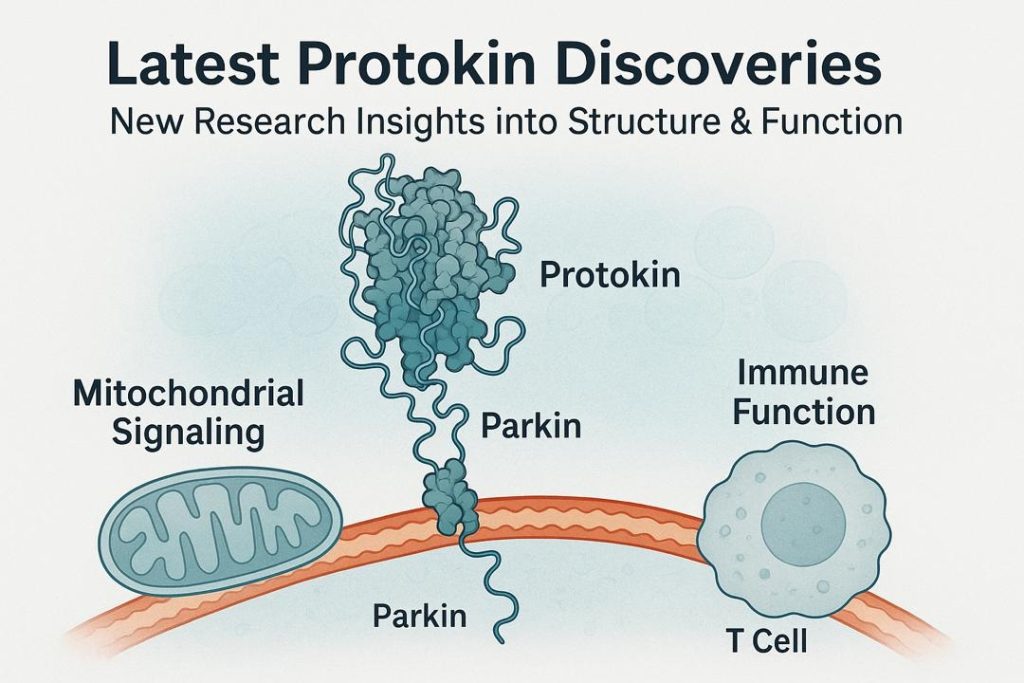Latest Protokin Discoveries: 2025 Breakthroughs in Structure and Function

What Are the Latest Protokin Discoveries?
The latest Protokin discoveries in 2025 have opened a new era in biomedical science. These findings include new insights into Protokin’s molecular structure, activation mechanisms, and its surprising role in immune modulation. From mitochondrial binding to immune system signaling, Protokin is proving to be more dynamic than ever imagined.
High-Resolution Structure of Protokin Identified
One of the most exciting latest Protokin discoveries is the first-ever atomic-level visualization of Protokin bound to mitochondrial membranes. (Related: Parkinson’s biomarkers research). Scientists now understand how Protokin changes shape when detecting stress signals, and how it activates downstream pathways for mitophagy. (Independent)
Functional Mechanisms of Protokin in Mitochondrial Signaling
The latest Protokin discoveries show a clear step-by-step sequence: stress detection, membrane binding, Parkin recruitment, and signaling for organelle cleanup. These insights are leading to exciting research in stem cell-based regenerative medicine. (WEHI)
Immune Role and T Cell Interaction with Protokin
Another breakthrough in the latest Protokin discoveries is its immune relevance. Studies have shown Protokin-specific T cells may drive autoimmunity, especially in Parkinson’s disease. This could lead to future diagnostic biomarkers or even vaccine strategies. (SciTechDaily)
Therapeutic Potential of Recent Protokin Research
The latest Protokin discoveries suggest strong therapeutic potential. Drugs targeting its activation domain or stabilizing its mitochondrial interaction could help in treating neurodegenerative and autoimmune diseases. (Explore immunotherapy insights)
Conclusion: What the Latest Protokin Discoveries Mean for Medicine
These latest Protokin discoveries provide essential knowledge that could transform diagnosis, treatment, and prevention of several diseases. Ongoing studies are now focused on translating this molecular knowledge into practical therapies for patients worldwide.
© 2025 P7 Neuro. All rights reserved.
Latest Protokin Discoveries: New Research Insights into Structure & Function
Introduction
The latest scientific research on Protokin, a pioneering bioactive protein, reveals groundbreaking new insights into its structure, activation mechanisms, and promising therapeutic potential. These findings have wide-ranging implications for drug development and understanding disease pathways.
1. First High-Resolution Structure Solved
In 2025, researchers published the first-ever high-resolution structure of Protokin bound to mitochondrial membranes. For the first time, scientists visualized Protokin docking into a mitochondrial translocator array, revealing its conformational activation steps. This structural atlas highlights how Protokin senses organelle damage and initiates signaling pathways. (Source)
2. Activation & Functional Mechanism Unveiled
The study elucidated a multi‑step activation pathway:
- Detection of mitochondrial stress
- Binding and stabilization on the membrane surface
- Ubiquitin tagging cascade with partner proteins like Parkin
- Recruitment of mitophagy machinery to clear damaged mitochondria
Key activation steps were previously unseen until this landmark structural work. (Source)
3. Immune System & T‑Cell Interactions Identified
In parallel, immunology research uncovered an unexpected role for Protokin in immune recognition. T cells targeting this protein may contribute to disease onset. Elevated levels of Protokin-specific T cells were associated with autoimmunity and showed sex-based prevalence differences. (Source)
4. Translational & Therapeutic Implications
Understanding Protokin’s precise structure and activation reveals novel drug targets to modulate its activity. Potential applications include designing small molecules or biologics that stabilize or enhance Protokin function, with therapeutic goals in mitochondrial disorders and immune-driven conditions. (Read more)
5. Future Directions
- Drug discovery targeting Protokin activation interface
- Clinical assays for Protokin-specific T cell profiling
- Research into sex-linked immune responses to Protokin
Conclusion
Recent studies delivering the first detailed Protokin structure, activation mechanism, and immune interface mark a major scientific breakthrough. These advancements lay the foundation for future therapeutic strategies—from drug design to diagnostic tools—that harness Protokin’s unique biological role.

